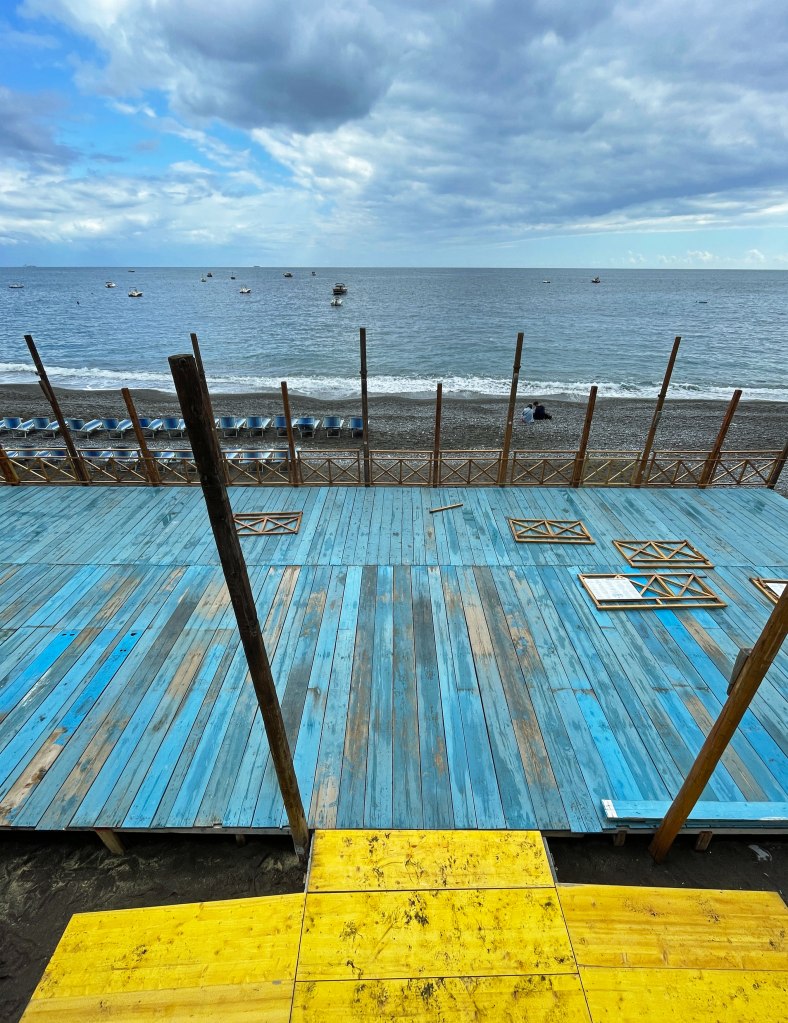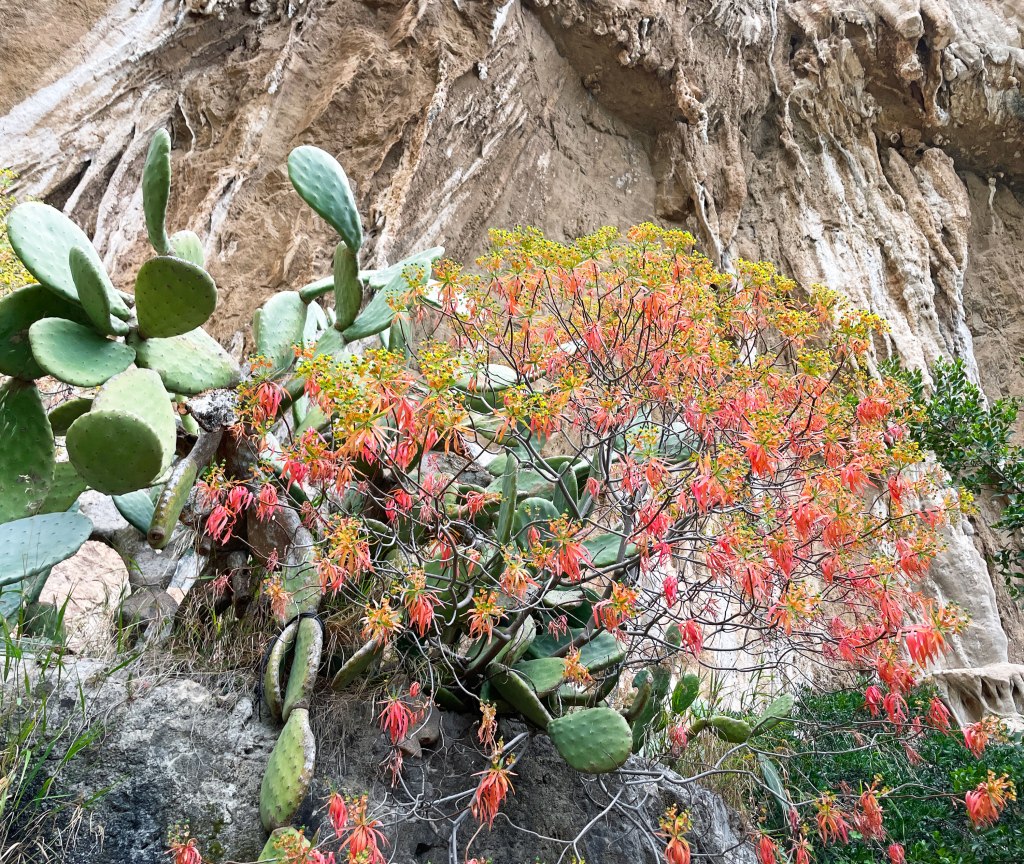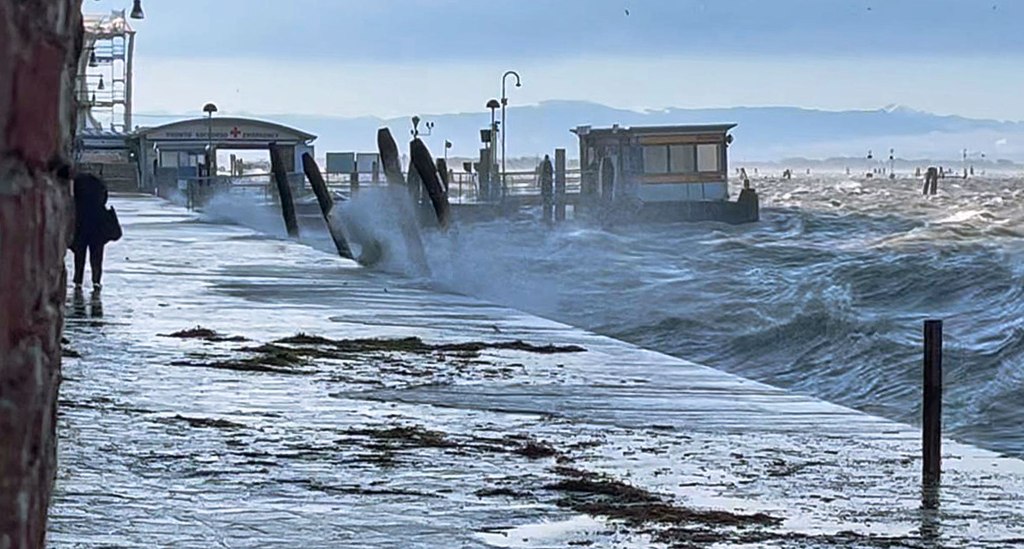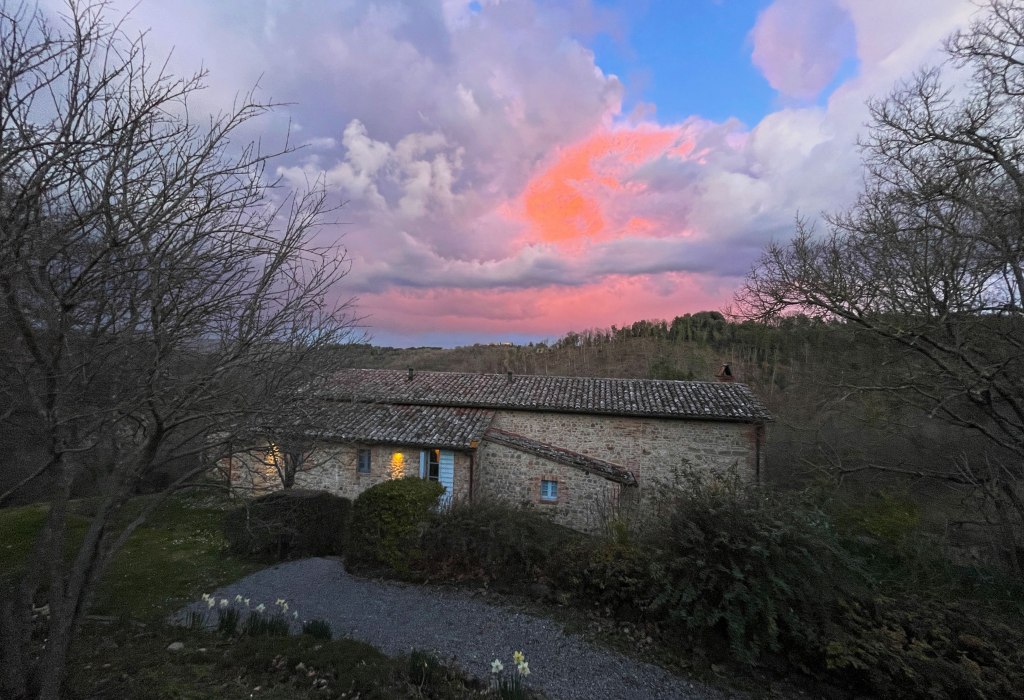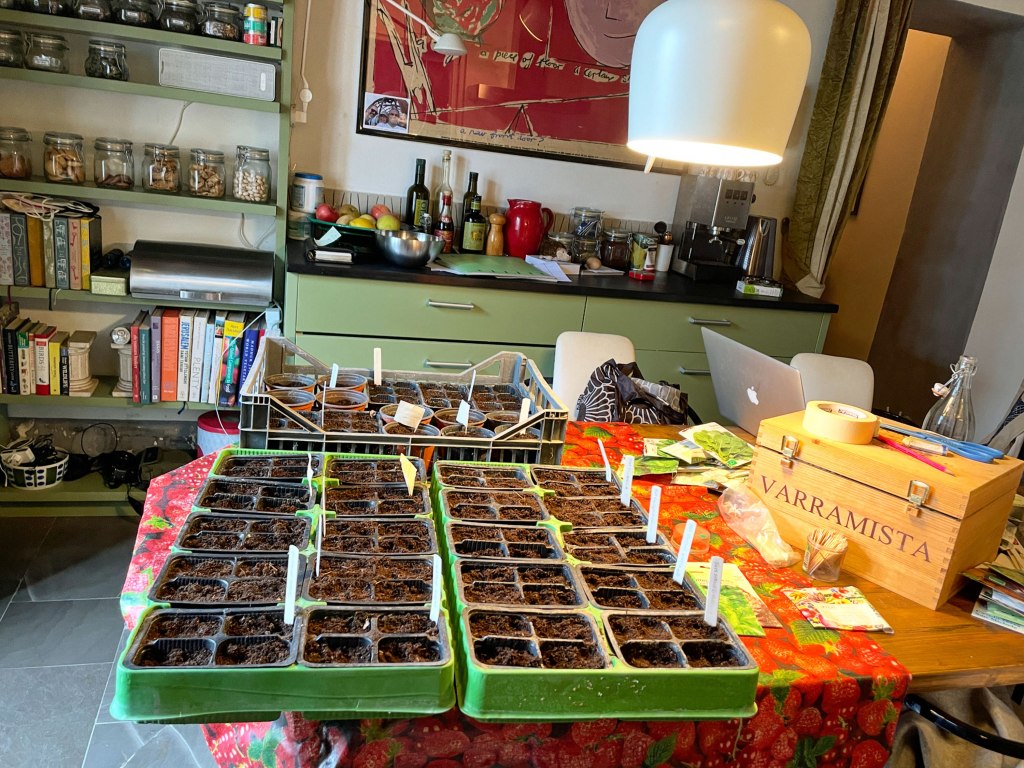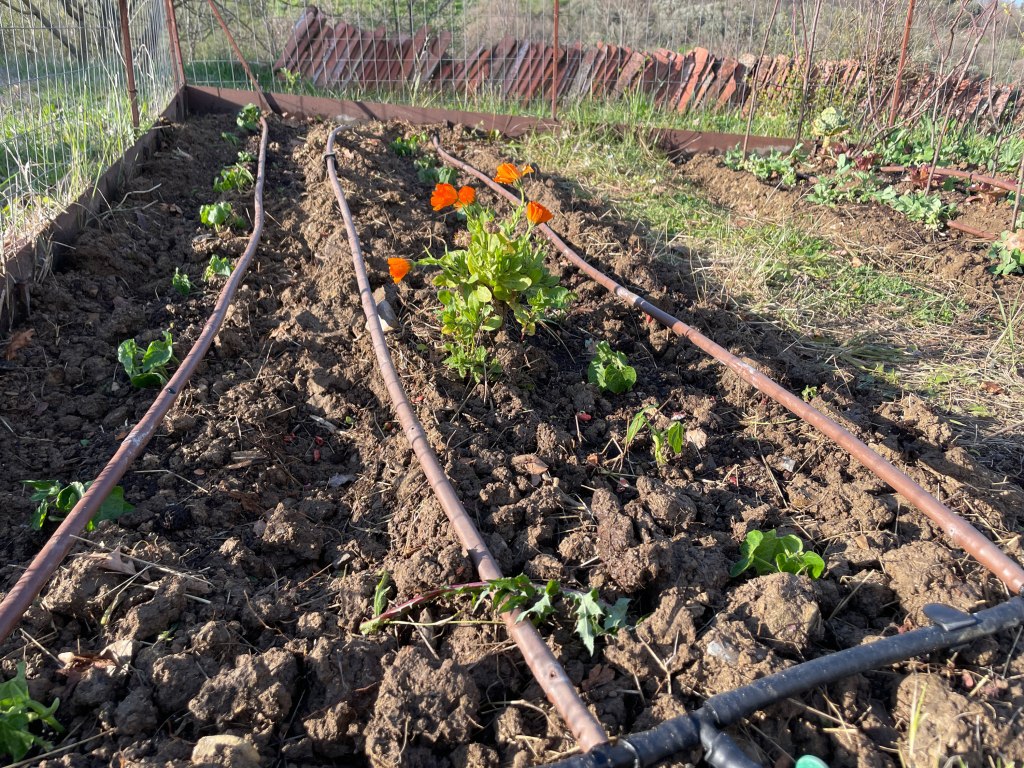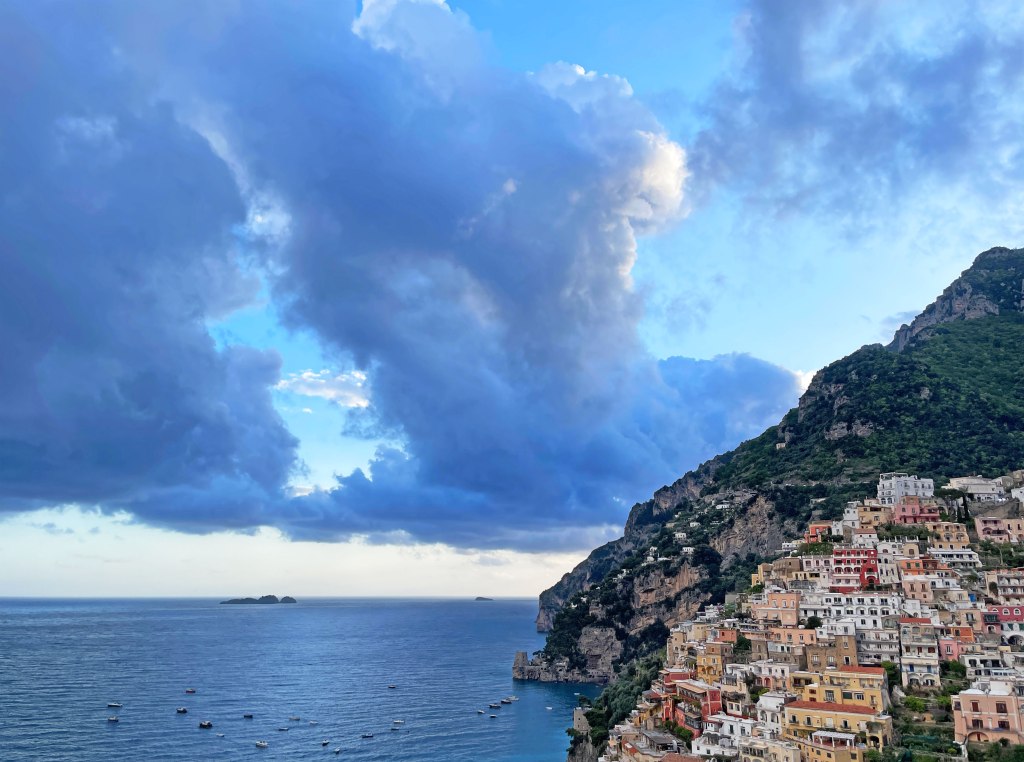
Gosh I’m tired after our six days away – tired from exertion, exhaustion, guilt, exercise and right now from insufficient sleep too. Why did I set my alarm quite so early?
Last bit first. This weekend was the unveiling of the latest artwork made for the Hotel Le Sirenuse in Positano. They commission an artist every year. This time, it’s in the pool. The rather charming, rather innocuous green mosaic interior has gone. In its place is a swirl of turquoises and indigos with a splash of stone hues borrowed from the cliffs above, care of Nicolas Party, the Swiss artist whose work we came across just a few months ago in the former chapel at the Casa Newton hotel in Pienza.
For this unveiling there was no celebratory plunging into the pool (though some guests did slip in quietly this morning, I noticed.) After weeks of July weather we’ve been transported back to how April should be – perhaps a little cooler even – hence a hasty rewrite of the weekend’s fun: no al fresco events along at the eastern extreme of town at the hotel owners’ exquisite hidden beach house, no mass dips either in the pool or at Fornillo beach where Saturday’s lunch was rerouted. On the covered balcony at that lunch two women looked enviously at my heavy sweater, saying they wished they’d had the foresight to bring something woolly.
The fact that L had already sneaked into the pool well before the inauguration – in March, in fact, when he was last there – says much about this odd spring. The outside temperature was warmer then; the water in the pool was freezing. But L being L, he couldn’t resist doing his ten lengths. Just as he couldn’t resist propelling me up hundreds of steps to the little town of Montepertuso on Saturday for breakfast. By the time we arrived at the bar, there was only one cornetto left: half a pastry is a mean reward for so much effort. Again – returning to our quaint little B&B from Fornillo, could we have just taken the most direct route? No: L devised the longest and step-iest challenge he could find. Something about Positano brings out the sporty masochist in him. Of course he’s justified because there’s no other feasible way to get from beautiful point A to equally beautiful point B in this vertical neck of the woods: everything is swiftly up or down. It’s just those steps…
I can walk forever on the flat and I’m slow but sure on inclines; steps on the other hand wipe me out. Lifting your knees that high to move forwards just doesn’t seem natural. But I did it and, I think, reaped some benefit. Or at the very least it made me feel less dreadful about tasting an awful lot of the 18 variations of pasta served in last night’s raucous, alcohol-soaked party.
As we drank champagne on the pool terrace, I was expecting speeches and cheers for the artist and ceremonial turnings on of pool lights. But there are no lights. I asked Antonio, owner of the hotel, about this choice. It was his late father Franco – a legend in Positano – who declared that no pool should ever be illuminated. As we spoke we were looking out over the town tumbling oh-so-picturesquely down the hill, just a little marred by its spattering of discordant ghost-lit, fluorescent pools. They’re so ugly. You can absolutely see Franco’s point. According to his father, Antonio said, pool water should change with the ambient light, and has to become dark enough to reflect its surroundings. He prefers candles dotted around the pool’s edge and their reflections constantly shifting on the pool’s surface. Again… who can fault him?
But pool lighting has moved on from the harsh flat effect of those ghastly constructions across the bay. And lined with Party’s artwork, the result would be anything but cold and ghost-like.
Still, full marks for taking up a perfectly reasonable position and sticking with it. My only real counter-argument for lighting it would be for the amusement of anyone taking a dip at night. Then again, perhaps that’s something that Antonio’s trying to avoid: having to have staff on hand through the evening to distribute towels to guests who then drip back semi-naked to their rooms across a terrace full of elegantly dressed diners is not necessarily what a hotel owner wants. In any case, the unlit night time effect is gorgeous.
At the event were a host of international darlings of the art world, many of them freshly descended from the Art Biennale opening in Venice. Just like us. In the sense that… that’s where we arrived from. In Venice, too, the weather was a feature.
I left a sunny warm Città della Pieve with a bag full of winter clothes: I’d looked at the forecast and I was sticking to my gloomy outlook. “Such beautiful weather!” L kept exclaiming when we arrived, giving significant looks at (what he considered) my otiose heavy overcoat. After which the heavens opened and a wind sprung up which even Venetians were saying threw the lagoon into a frothy turmoil the like of which they’d never witnessed before. Trees and branches came down and flowerpots flew. The wail of boat-ambulances began. It was hugely dramatic. (Storm photo thanks to Lee Marshall.)
The pattern held for the next couple of days: nice-ish chilly mornings, then sudden afternoon storms, though nothing quite so wild as that first day. I was glad I had my rain cape with me: beyond that satifying feeling of whooshing through the calli enveloped in something long and flowing, it also kept me dry+mobile. L was a little damper.
There was a strange dichotomy in the city: regular tourist-wise, Venice was weirdly uncrowded… nothing like I expected. Walking through St Mark’s square during one sunny patch of afternoon, café tables were empty and pedestrians were scarce. Very strange.
Not so in the Biennale locations where I’d never seen such crowds: at times it was just plain unpleasant. And the queues! Any exhibit that people were talking about was unapproachable. “The German pavilion! You must see the German pavilion. It’s so strong!” But after a 40-minute wait outside the pavilion and another 45 minutes in a shuffling line inside to get into the cylindrical structure housing the main exhibit, strength wasn’t on my mind: what I was feeling was resentment with a touch of loathing. We resolved that from now on we’d skip the glamorous bustle of the vernissage and just come later with the regular punters.

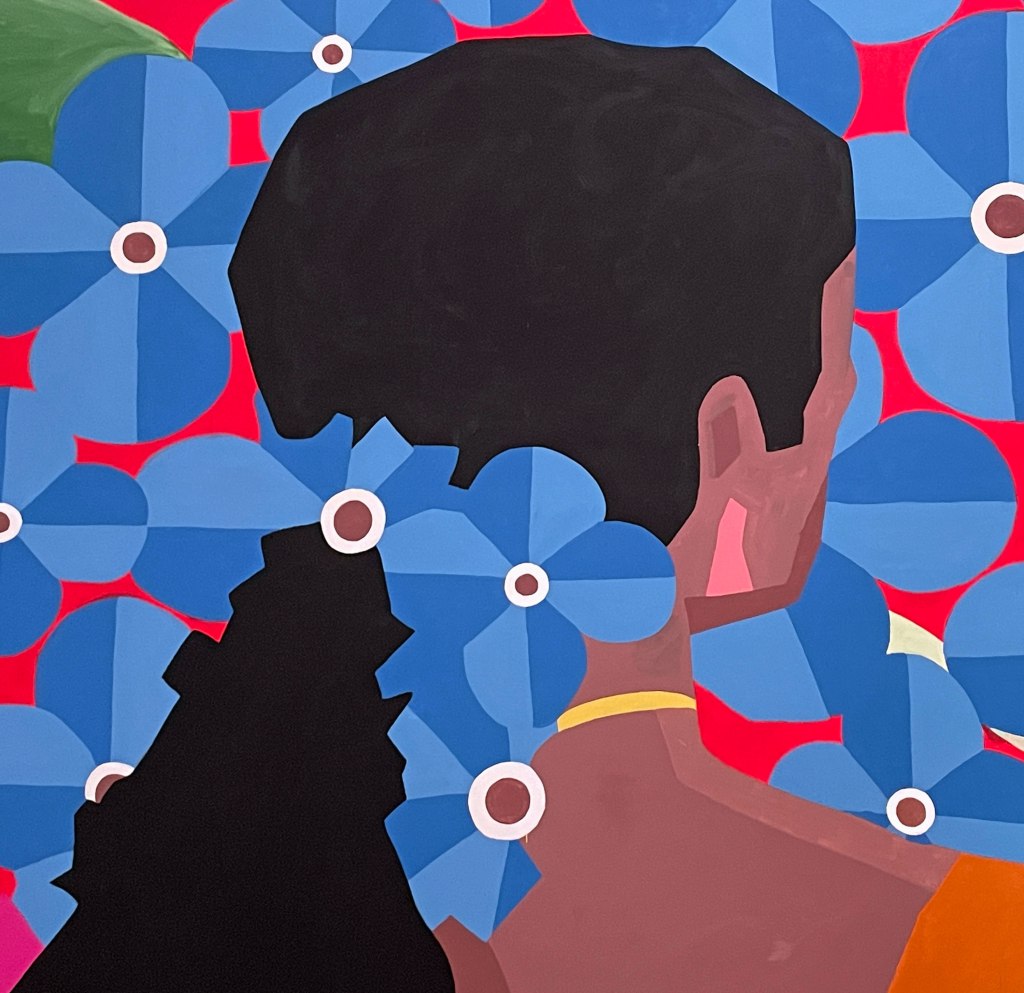
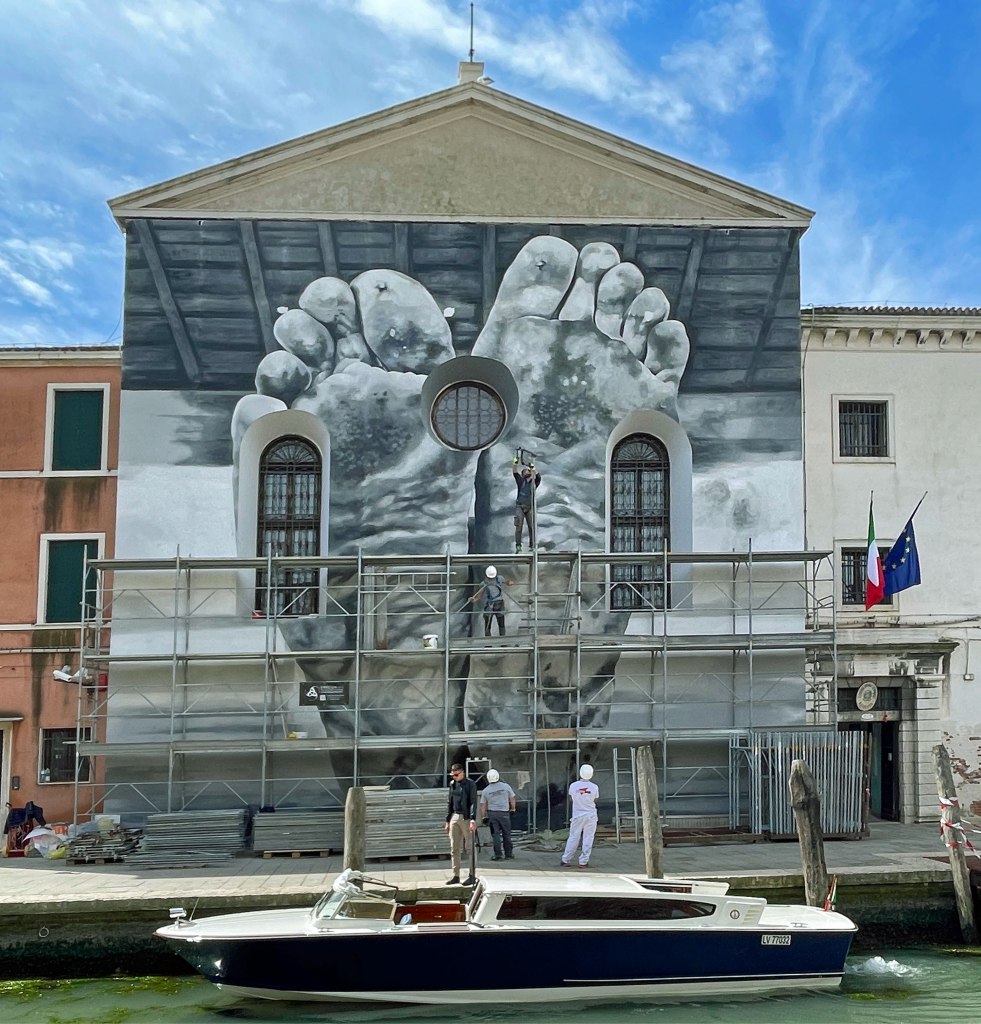
Looking back now it’s all a jumble in my head. Random thoughts: there was a lot of painting, with paints and canvasses, and much of it by dead people. It’s not what you expect at the Biennale – to the point where on the first day, going through the pavilions in the Giardini, I actually found myself longing for the kind of ridiculously over the top creations which in other years have left me furious and frustrated. At the beginning, I simply wasn’t feeling challenged. This wore off however, and the coherence of the thing became more appealing: Stranieri ovunque – Foreigners Everywhere threw up lots of interesting angles.
We naturally missed a huge amount, in particular the various large-scale peripheral shows like the Jean Cocteau at the Guggenheim and the Pierre Huyghe at the Punta della Dogana which everyone said were fab. We’ll be back though.
There were fascinating things like the room full of photographs from the period when the Americans were extending their control over Puerto/Porto Rico which gripped me, but did rather have me wondering: “is this art?” I guess its artiness lies in the intention. Similarly the Mapping Journey Project, a video installation by Bouchra Khalili in which we hear voices of migrants and refugees and see their hands mapping the routes of their travels on the kind of maps you find in Italian school textbooks. Powerful and fascinating. But I have to make a huge effort to think of it as art.
The Japanese pavilion was charming and playful; the British pavilion had a video installation by John Akomfrah which was the first UK exhibit in many years which I’d not stalked out of immediately, wondering whether they were taking the piss; there was an eerie, humorous and kind of distressing peacefulness about the Bulgarian exhibit where a soundscape of stories told by prisoners from Soviet labour camps whispers through a reconstructed Soviet-era flat; I found the beadwork in the Canadian pavilion strangely serene; and the video by Norwegian-Sudanese artist Ahmed Umar of himself doing a Sudanese bridal dance is totally mesmerising.
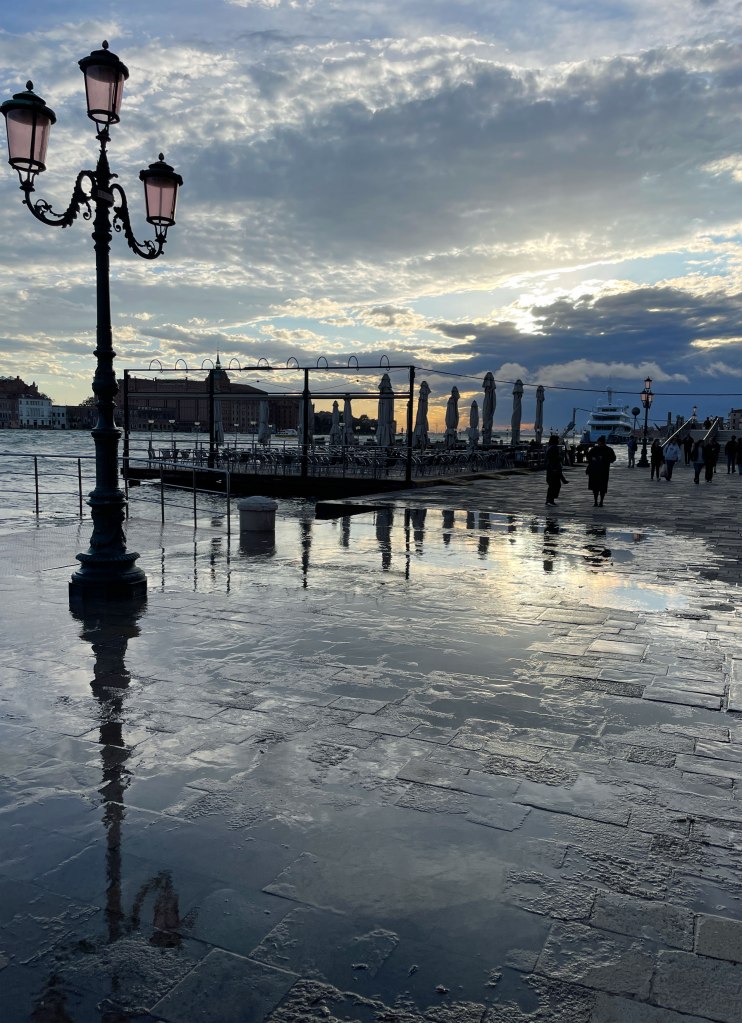
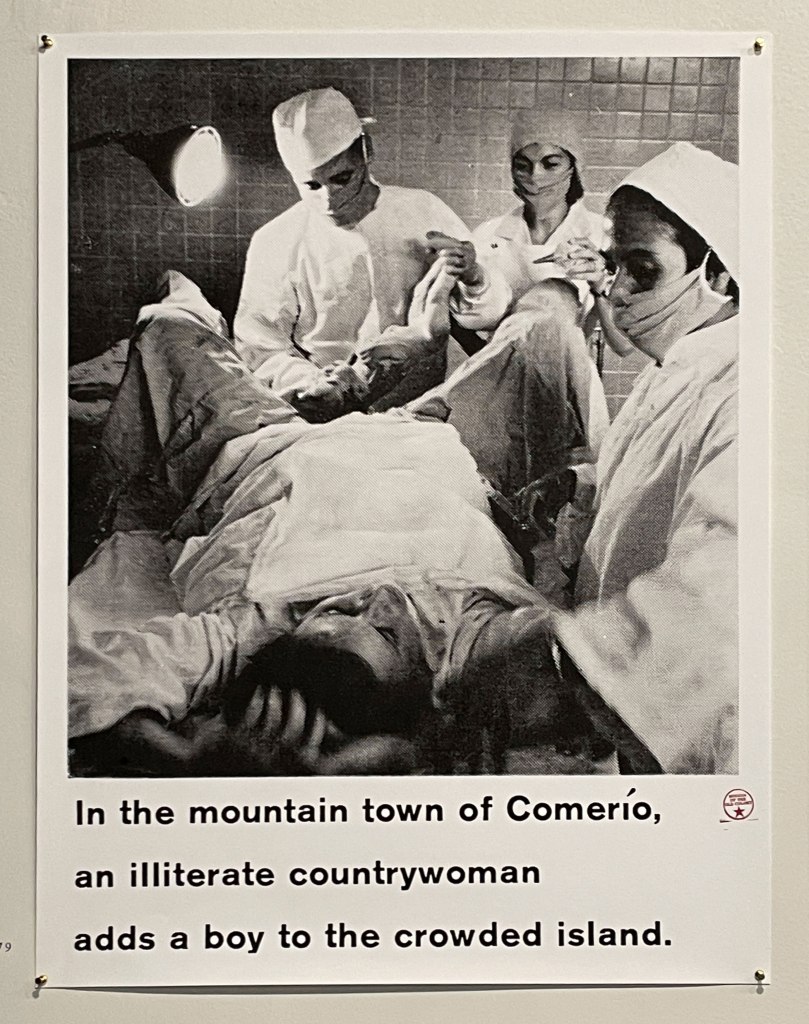
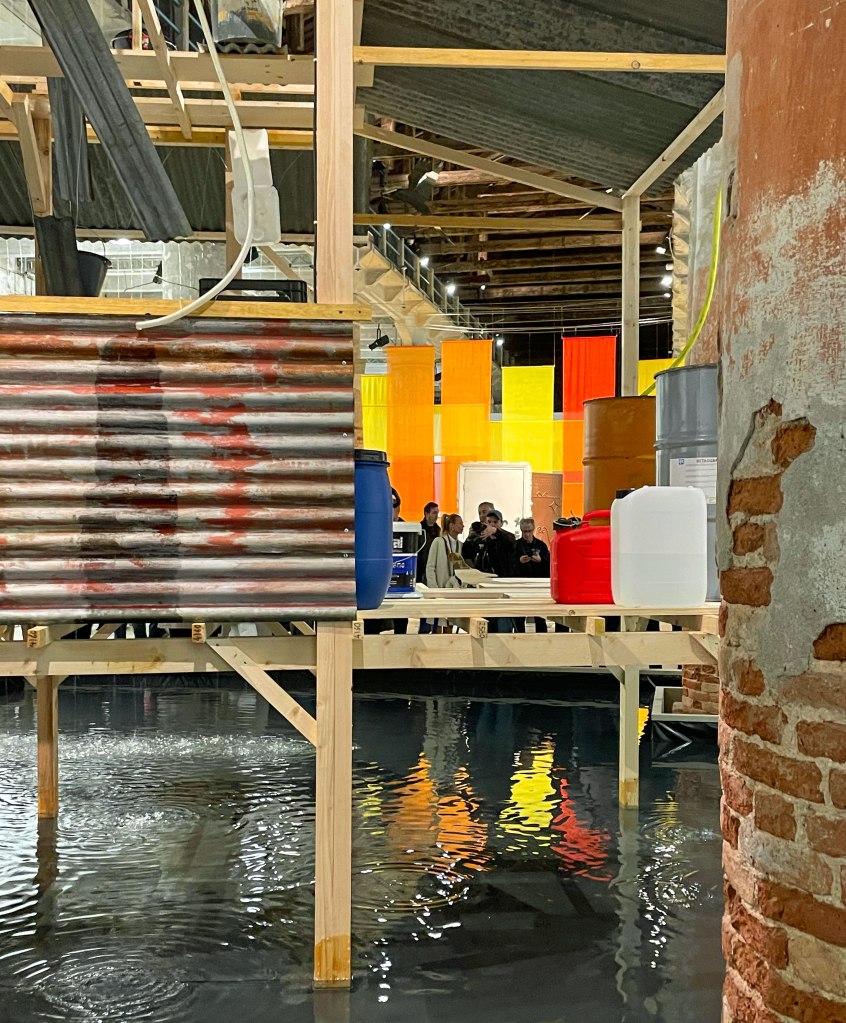
That the Golden Lion went to Australian artist Archie Moore gave me great pleasure: no queues here because it was a little under the radar. On the walls and ceilings of a black space he’d chalked a huge family tree spanning countless generations with names and descriptions and racial classifications and comic nicknames: the vastness of it all gave a strange sense of connectedness. On a platform in the centre of the room, surrounded by a shallow pool of water, were neat white piles of redacted dossiers on Australian First Nation people who have died in police custody. This was strong.
The oddest pavilion we visited was the Vatican one, inside the women’s prison on the Giudecca. There was the usual bureaucratic palaver to get in (we experienced this last summer in the high-security prison in Spoleto) and then the tightly controlled rigmarole inside. Various foreign journalists in our pack were moaning/laughing at the Italian-ness of the procedure but frankly, I think it would be much the same anywhere in the world. Many of the Brits and Americans were marvelling at the prison staff. “They’re young, they’re slim, they’re so stylish!” You wouldn’t get that, they agreed, back home. (No photos of the prison I’m afraid: anything electronic/digital was confiscated and locked away before you could enter.)
The art, quite frankly, was underwhelming. The choice of artists was difficult to fathom – apparently utterly random. Those projects done in conjunction with the inmates (the three inmate-guides, all wearing lovely dark blue and white cotton coats produced in the prison’s tailor shop, tried hard to refer to themselves as ospiti (guests), but slipped from time to time) at least had the virtue of having a narrative; other pieces just appeared to have been plonked there.
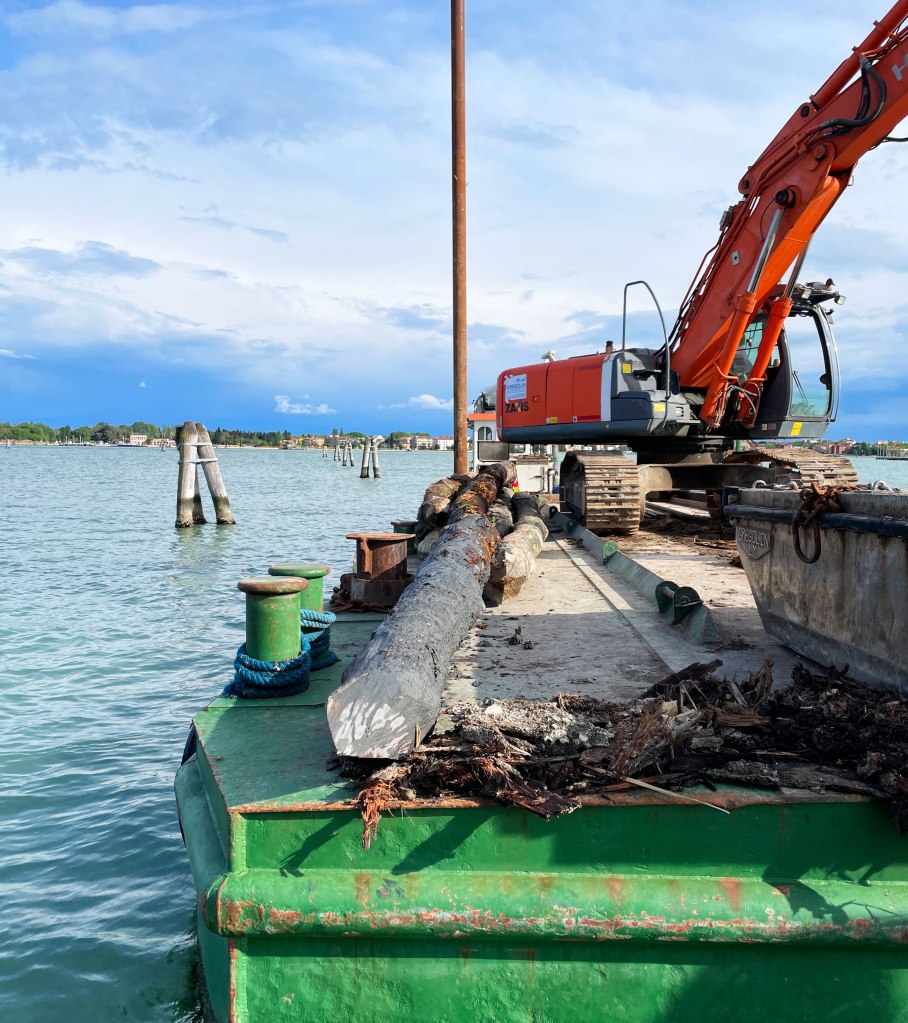
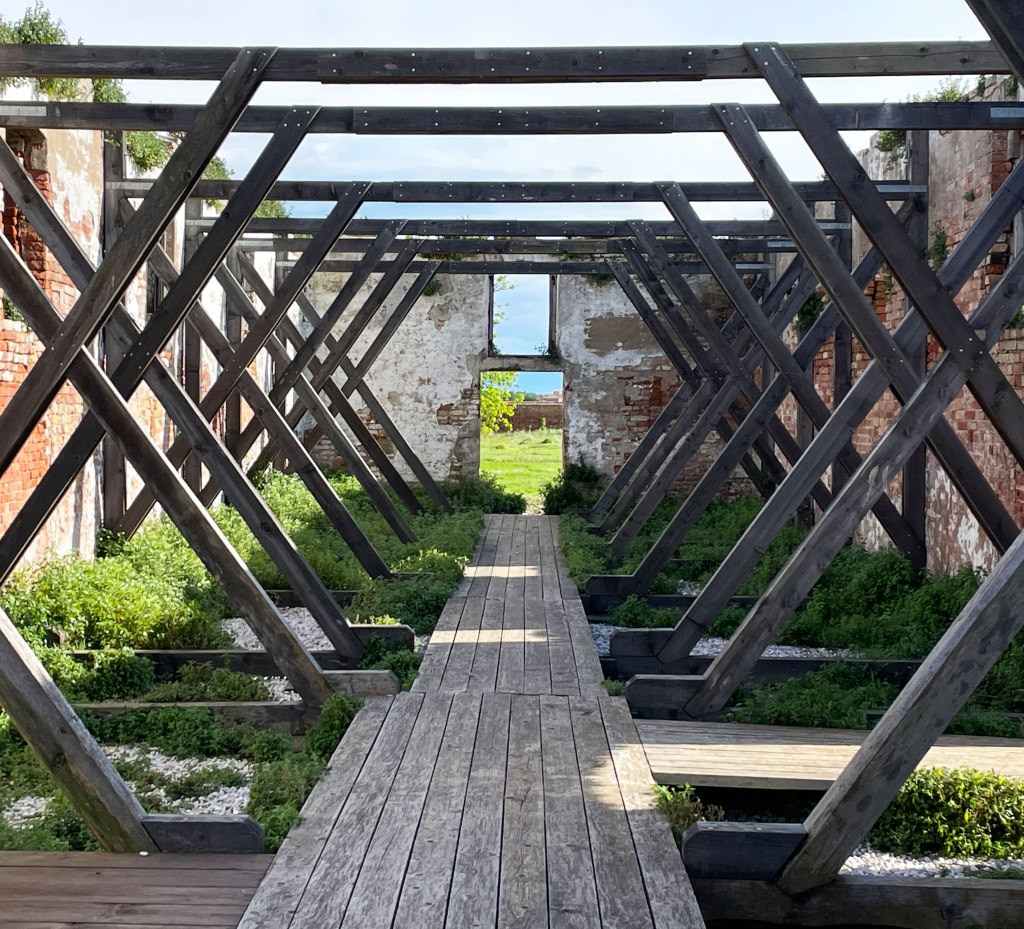
It was fun, though, to get a glimpse of the prison’s beautiful vegetable garden, and to see the odd enclosed microcosm of Venice. The place is built around a vast stone-floored campo (square) which is much like any campo outside the walls; another open space is filled with a very green, rather unkempt garden full of kiddies’ playground stuff: all very domestic.
I’m no fan of Maurizio Cattelan as a rule but in this show he provided what was for me the most striking piece: foreshortened feet recalling Mantegna’s Lamentation over the dead Christ painted huge on the outside wall of the prison chapel: interesting though that he was the only artist involved who opted to make his contribution invisible to the women inside. Did he not get the memo?
Another memorable moment was the Midnight Whisky talk held in a bookish apartment (whose? who knows…) along the Riva where artist William Kentridge bantered with Walter Murch, the legendary film editor, like the two old friends that they are. Murch has recently edited Kentridge’s latest film-animation venture, Self-portrait as a Coffeepot. The whole thing had the feel of a little piece of an era which is almost bygone. Such a pity, then, that I kept nodding off. Midnight’s not a great hour for events when you’ve been on your feet all day.
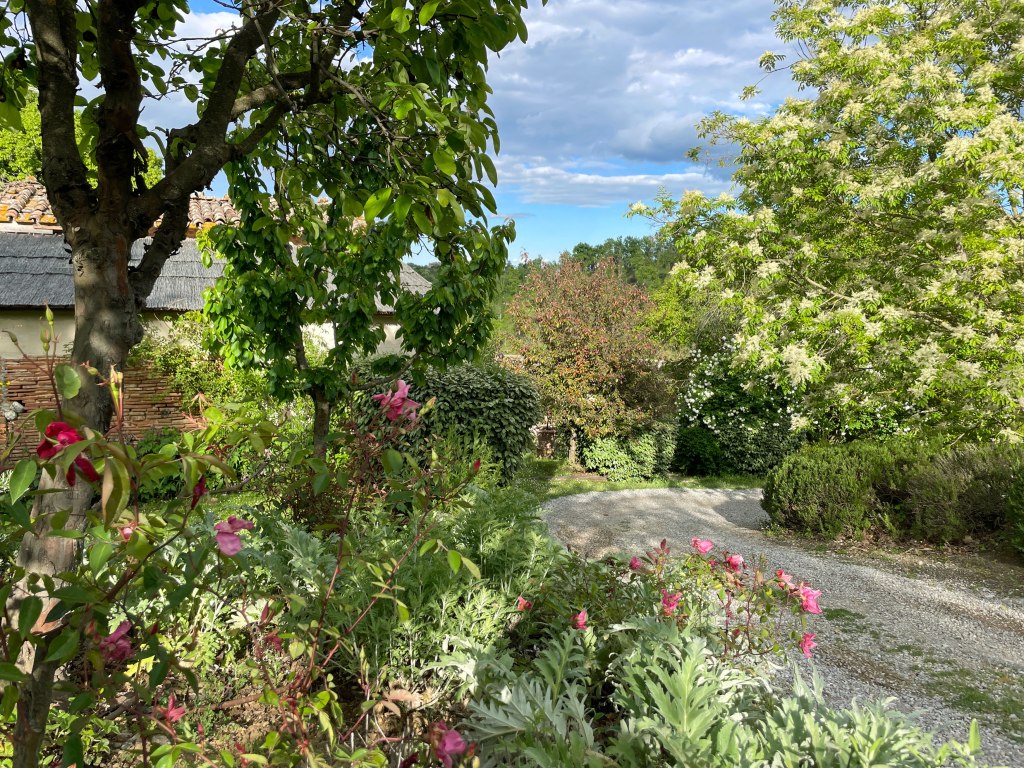
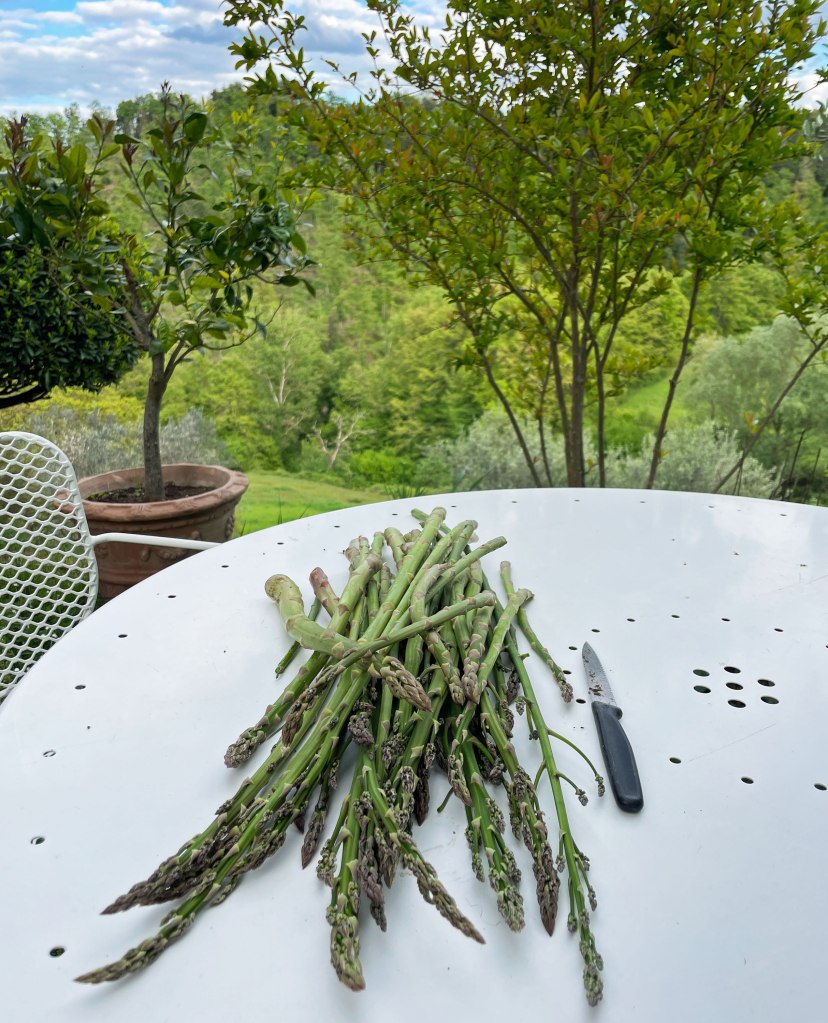
What have I come home to? Everything blooming, an immense pile of asparagus needing to be eaten, vegetable seedlings which survived my absence and are pleading to be put in the ground, pea plants which really haven’t bothered to grow too much but which are busy producing outsize pods inside which tiny peas are swelling.
I come back, too, to face the guilt which I mentioned way up there at the top of this meandering scribble. I mean: what kind of garden designer takes the best part of a week off in mid-April? How irresponsible is that?
Actually, many months ago when planned, the jaunt seemed like a perfectly feasible last-dash break before the spring sprint begins. I don’t feel comfortable doing too much in April: there’s always the risk of a meteorological sting in the tail and anyway, there’s the whole of May and much of June stretching ahead of you in which to get things into the ground. Ha!
The days of warmth which preceded this drop in temperatures brought everything galloping forward, and the cold snap which I predicted has now come when it’s too late (or at least I hope it’s too late) to present itself in the form of devastating frost and/or surprise snow. Though that said, there’s plenty of snow to be seen on the peaks in the distance to the east, and you can feel it in the air.
Moreover, some favourite and valued clients have requested certain things be done within certain deadlines and those deadlines are… scarily close. It’s going to be a busy couple of weeks. I think I need to light a candle for no rain and perfect planting conditions.

